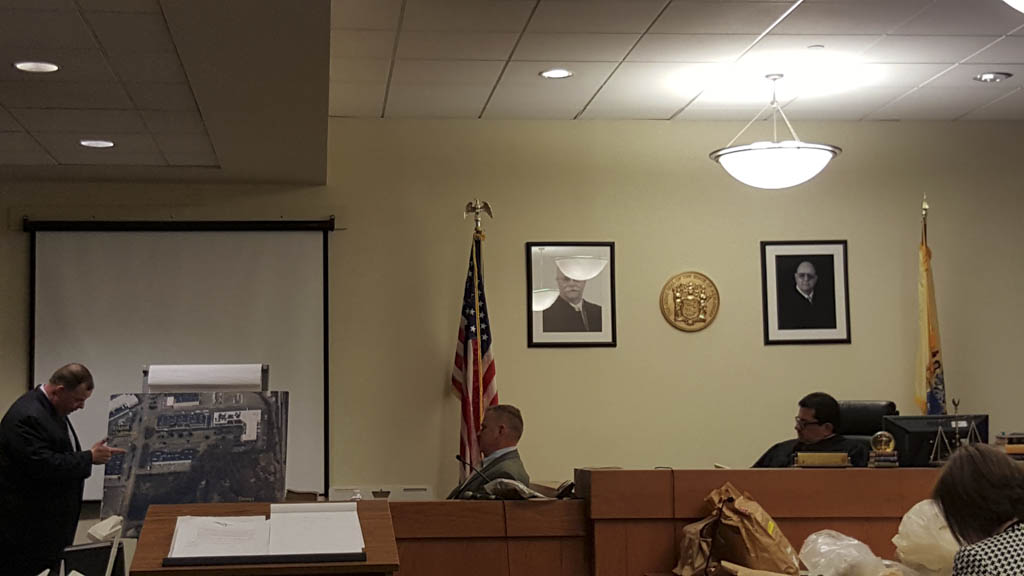By KATHY CHANG
Staff Writer
NEW BRUNSWICK — A crime scene investigation expert took the stand and said the mishandling of a blanket by police found in 1992 where Timothy “Timmy” Wiltsey’s body was found calls into question its connection with the boy’s disappearance.
Howard Ryan, a retired New Jersey State Police officer, told the jury in the trial of Michelle Lodzinski, who is being tried for the murder of her son Timmy in 1991, that in the review of the reports, he found little documentation of items found with Timmy’s remains.
Timmy’s skeletal remains were found in a creek on April 23, 1992, in a remote section of the Raritan Center industrial park in Edison, which is made up of marshlands and wetlands, 11 months after he was reported missing from a carnival at Kennedy Park in Sayreville on May 25, 1991.
The blue and white blanket was found on top of an embankment from where Timmy’s remains were found by retired FBI agent Ron Butkiewicz, who investigated the case in 1991 and 1992.
“There was no picture taken [of the blanket]. … It was picked up and moved,” Ryan said, adding that as a crime scene investigator there are safeguards and protocols in handling items of evidentiary value.
The identification of the blanket by people who babysat Timmy led to Lodzinski’s indictment by a Middlesex County grand jury in July 2014, followed by her arrest in Florida and extradition to New Jersey.
During the trial, Danielle Gerding, who was 14 years old in 1991, told the jury that she was a good friend of Lodzinski’s niece, Jennifer Blair Dilcher, at the time. When authorities showed her the blanket when they reopened the case, she told them she recognized the blanket as being in Lodzinski’s apartment when she lived on Broadway in South Amboy.
She said when Blair would babysit Timmy and sleep over her aunt’s home, the blanket was the one she would use when she slept on the couch.
In tears, Dilcher testified that she recognized the blanket, turning away as Assistant Prosecutor Scott LaMountain held it up.
Dilcher said she used the blanket to snuggle up with Timmy at Lodzinski’s apartment on Broadway.
Dawn Matthews, who said she did not know Dilcher or Gerding, testified she last saw the blanket when Lodzinski lived on Pine Avenue in South Amboy. Matthews was a neighbor on Pine Avenue, while she also served as a babysitter.
She said Timmy would use the blue and white blanket that had metallic threading in it when she used to babysit him.
Ryan said the fact that a hair was found on the blanket when the case was reopened in 2011 and no hair was found initially when the blanket was analyzed in 1992 is alarming.
“What happened [with the blanket] in between?” he said. “At some point [the blanket] was mishandled.”
Ryan said when reviewing the reports, he said since only 6 percent of Timmy’s remains were found, he, as a crime scene investigator, has to ask, “Where is the other 94 percent?”
He said since Timmy’s remains were found in water, he would need to strongly consider water as well as animal activity.
Ryan, who said he did not do his own investigation of the items found, said there was nothing of evidentiary value to tell if Timmy was dumped or killed at the site.
“This was a body-recovery site,” he said.
Ryan said with the mishandling of some of the items found during the investigation, it is difficult to link any of the items to Timmy.
On cross-examination, LaMountain asked Ryan if the remote location where Timmy’s remains were found was a good place to dump a body.
“It’s a pretty remote area. … Sure, it’s smarter [to dump a body] there than the center of the city,” he said.
LaMountain asked Ryan if he considered forensic anthropologist Donna Fontana’s report, who analyzed the 11 found bones of Timmy.
Ryan said in his review of the case he was not given Fontana’s report.
LaMountain asked about Fontana’s conclusion that Timmy’s body decomposed in the location where he was found, since the heavier bones were found in and around the area of the skull and the coloration of the bones had taken the color of its environment.
Ryan said it wouldn’t change his opinion, noting that no one knows or ever will know if Timmy was killed at the site.
LaMountain asked Ryan if the link — that the Teenage Mutant Ninja Turtle size 13 boys’ sneakers found at the site of Timmy’s remains were determined to be Timmy’s since Lodzinski brought a shoebox to Sayreville police headquarters in 1991 that matched the shoes — changed his opinion on the linkage of items.
Ryan called the link circumstantial evidence.
LaMountain then asked Ryan if he, as a trained law enforcement official, would take into consideration three different people, who did not know each other, identifying the blanket as an important part of the investigation.
“That’s their opinion,” Ryan said, adding that he would ask if there was a reason they would say that.
Ryan said the problem is the documentation of the items at the crime scene.
LaMountain then showed Ryan an enlarged photo of the site where Timmy’s remains were found and asked Ryan if he would take into consideration the fact that Lodzinski worked three-fourths of a mile from where Timmy’s remains were found.
Ryan answered, “Actually, no,” noting that there were no measurements on the photo.
Through testimony, the jury learned that Lodzinski had worked at Florida Fulfillment, located at 375 Raritan Center Parkway from September 1988 through March 1989.
The trial is expected to last three months.

